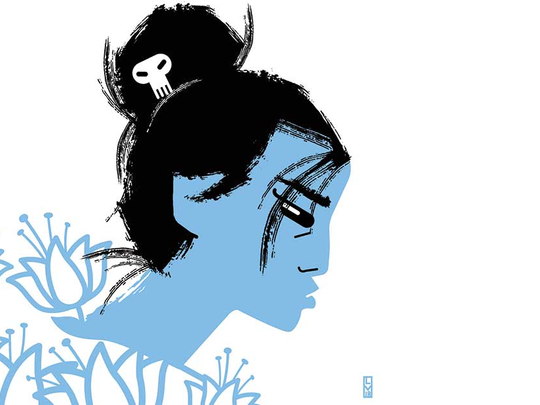
By Han Kang, Granta Books, 128 pages, £10
When I first read Han Kang’s modernist masterpiece, The Vegetarian, its accumulative effect was shattering. I knew that I was engaging with the most sophisticated kind of writing intelligence. How thrilling it was to discover the work of a major contemporary Korean writer. But what was it about? The core of the story features an apparently unremarkable woman who refuses to eat meat and is therefore subjected to crazed violence by her family. Yet it is also about authoritarian control, all the dimensions of desire — including the renunciation of desire — and the ways in which we make a bid to live a life that feels less wrong.
Han won the 2016 Man Booker International prize for The Vegetarian, along with her translator Deborah Smith. Quite right, too. It requires immense skill to translate the literary techniques at work in a novel of this kind: the depth charge of its pared-down language, its cadence, the intricate web of connecting conversations with readers, and above all, the aesthetic sensibility of the whole composition. Smith also translated Han’s astonishing 2016 novel, Human Acts.
The White Book is not designed to have the narrative reach of those two novels. Instead, it is a fragmented autobiographical meditation on the death of the unnamed narrator’s baby sister, who died two hours after her birth. Han wisely gives as much value to those heightened two hours of life as she does to her death. The story of her birth, as narrated from the point of view of the mother, who is 22 when she is obliged to deliver the premature baby herself, is simply told.
Now and then her mother would be struck by a sense of foreboding and give a corner of the quilt a tug, but the baby’s eyes opened only briefly, grew dim and then slid shut. At some point, even that scant response was no longer forthcoming. And yet, before dawn, when the first milk finally came from her mother’s breasts and she pressed her nipple between the tiny lips, she found that, despite everything, the baby was still breathing. Though she had, by now, slipped from consciousness, the nipple in her mouth encouraged a soft swallowing, gradually growing stronger. Still with her eyes closed the whole time. Not knowing what boundary, she was now passing over.
It is as if this story itself has become a womb in which the author “has grown up inside”. Han wrote it while she was on a writer’s residency in Warsaw. When, in the novel, she walks around a building that was once destroyed in a 1944 air raid and then rebuilt, she observes how it has been faithfully reconstructed, incorporating into its new structure an old pillar that had survived. She understands that her sister’s presence, like that pillar, is part of her history, and wonders if in writing about her death, she could give her new life.
This Sebaldian idea is the most interesting aspect of The White Book, and it certainly inspires its most substantial writing. The narrator proceeds to make a list of the white things that are directly or obliquely in conversation with her sister’s death and life: swaddling bands, salt, rice, bones, pills, hair, breast milk, fog ... She hopes that the process of writing “would be transformative, would itself transform, into something like white ointment applied to a swelling, like gauze laid over a wound”.
The book is structured around the white things that become part of the rituals of mourning and remembering. Reflecting on a particular white pebble, Han notes: “If silence could be condensed into the smallest, most solid object, this is how it would feel.” The dominant theme is of transience, of fleeting life and the acceptance of human fragility. A snow storm in Warsaw erases the detail of its streets, yet when it falls on a black coat sleeve, it will “reveal its crystals even to the naked eye. Mysterious hexagons melting clean away.”
Now and again, another colour interrupts this palette of white: the red feet of a bird, a crane making its way out of the water towards a rock. Only when the creature believes it will not be hurt by the human observing its journey does it stand still and allow the sun to dry its feet.
At its most engaging, the writing edges close to becoming a brilliant psychogeography of grief, moving as it does between place, history and memory. If Han’s monotone is relentlessly poised and never flinches from serene dignity, perhaps it could not be written in any other way. It is a pleasure to come across a white thing that is not as literal as white pills or white hair, such as the phrase, “laughing whitely”, an expression the narrator explains probably “exists only in her mother tongue”. To laugh whitely means to laugh but not to mean it: “Laughter that is faint, cheerless, its cleanness easily shattered. And the face that forms it.”
The White Book is a mysterious text, perhaps in part a secular prayer book. I admire its intention, form and purpose. Some of the most affecting writing comes when the narrator speaks directly to her baby sister. “I wanted to show you clean things. Before brutality, sadness, despair, filth, pain, clean things that were only for you, clean things above all. But it didn’t come off as I intended. Again and again I peered into your eyes, as though searching for form in a deep, black mirror.”
Translated seamlessly by Smith, The White Book succeeds in reflecting Han’s urgent desire to transcend pain with language.
–Guardian News & Media Ltd
Deborah Levy’s memoir, The Cost of Living, will be published this year.









